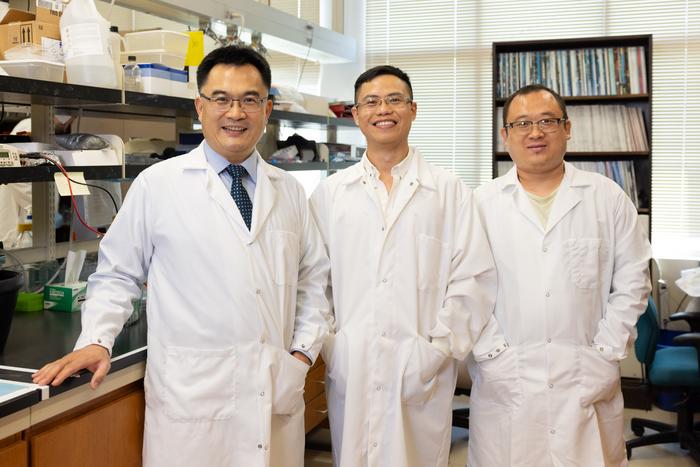New research from a team of genome scientists and DNA damage response experts breaks new ground in understanding the function of a protein currently limited in clinical trials for cancer treatments.

Credit: UNC Charlotte
New research from a team of genome scientists and DNA damage response experts breaks new ground in understanding the function of a protein currently limited in clinical trials for cancer treatments.
Led by Haichao Zhao, PhD, in the Yan Lab at UNC Charlotte, the new research shows how ATM-mediated signaling is induced by DNA single-strand breaks (SSBs) for DNA damage repair – illuminating the distinct mechanisms of SSB-induced ATM kinase and shedding an important light on APE1 function.
In the new study, published today in Nature Communications, researchers demonstrate their use of plasmid-based SSB structures to examine APE1’s critical role in DNA damage response (DDR) signaling pathways. Among other findings, the publication details results showing SSB induces ATM activation prior to ATR, temporarily arresting cell cycle progression as DNA attempts to undergo repair. And – central to the study’s significance – the team discovere direct evidence for the active role played by APE1, a multifunctional enzyme, in SSB-induced ATM DDR signaling.
“We demonstrate that APE1 promotes SSB-induced ATM DDR through at least two mechanisms: APE1 exonuclease activity-mediated SSB processing and APE1-mediated direct recruitment of ATM to SSBs,” researchers wrote.
Building upon the Yan Lab’s prior work at UNC Charlotte, the findings are a strong step forward in our understanding of SSB DNA repair and cellular response – and may contribute to future therapeutic inhibitor options for a range of human diseases, such as cancer and heart failure.
Shan Yan, PhD – Professor, Associate Chair for Research in UNC Charlotte’s Department of Biological Sciences, and program leader of Charlotte’s Genome Integrity and Cancer Initiative (GICI) – says: “These findings will impact the field for years to come.”
“We’ve changed the understanding of how ATM signaling is activated,” Yan said.
Lead author of “Distinct regulation of ATM signaling by DNA single-strand breaks and APE1,” Haichao Zhao offered that the research may support future clinical trials – both for attacking cancer cells and other life-threatening conditions and for protecting non-malignant cells during treatments.
“The more data or information about DNA damage (and repair) we have, the better we may develop treatments for cancer patients,” Zhao said.
DNA damage response is an evolutionary pathway, designed to maintain genome integrity as human cells are under near-constant attack, by both internal and external factors. DNA lesions generally trigger DDR – signaling a “cascade,” as the study puts it, of transcription activation, repair, and cell cycle arrests.
While DNA damage repair research is far more established for cellular response to double-strand breaks (DSBs), Zhao and Yan say knowledge gaps surrounding SSBs have persisted. In particular, Yan said, molecular biologists have had little to no direct evidence about the precise function of APE1 at SSB sites.
In the past, researchers have generally regarded functional DSB studies to be more urgent, Zhao points out, as this type of DNA damage is closely associated with cancer. However, SSBs can foreshadow the development of more lethal double-strand damage. In addition, SSB damage occurs far more frequently – more than 10,000 times per day in a human cell. In each instance, repair mechanisms must take place to protect genome integrity. The accumulation of SSBs over time is thought to contribute to or cause cancer and disease.
Breakthroughs in SSB research, Zhao said, hold potential for future translational and clinical response to “upstream” health risks.
The research from Zhao, et. al., clearly establishes, for the first time, APE1’s function as a direct activator of ATM kinase to promote the repair of single-strand DNA damage. The study also provides direct evidence that the ATM-dependent DDR pathway is activated by a SSB of a defined DNA structure.
Further, the UNC Charlotte study brings forth an intriguing inquiry on whether APE1 over-expression can be shown consistently to activate ATM in the absence of DNA. The team poses the question, pointing to the study HSS system where APE1 oligomerized – demonstrating direct ATM kinase stimulation in vitro.
From the study, where researchers make the case for future experiments: “What is the potential role of the APE1 overexpression-induced ATM-mediated DDR signaling? APE1 is often found over-expressed in cancer cells … and associated with poor overall survival in cancer patients.”
In the Yan lab, researchers utilized eggs from female Xenopus laevis (African clawed frogs) to produce high-speed supernatant (HSS) egg extracts, later introducing purified plasmid DNA structures from E. coli. Researchers then incubated different concentrations of SSB and control plasmid in the HSS. In response, the study showed, APE1 was “recruited to SSB plasmid at an early stage of SSB signaling.” And, the research reveals ATM is activated by SSBs.
“Both ATM and ATR DDR pathways are being targeted in clinical trials for diseases such as cancer, which highlights the significance of basic mechanistic studies on how ATM and ATR are activated to maintain genome stability,” the researchers wrote.
###
The Yan laboratory is supported in part by grants from the NIH/NIEHS (R21ES032966), NIH/NCI (R01CA225637 and R03CA270663), and funds from the University of North Carolina at Charlotte.
“Distinct regulation of ATM signaling by DNA single-strand breaks and APE1,” by Haichao Zhao, Jia Li, Zhongsheng You, Howard D. Lindsay, and Shan Yan in Nature Communications.
Journal
Nature Communications
Method of Research
Experimental study
Article Title
Distinct regulation of ATM signaling by DNA single-strand breaks and APE1
Article Publication Date
7-Aug-2024



